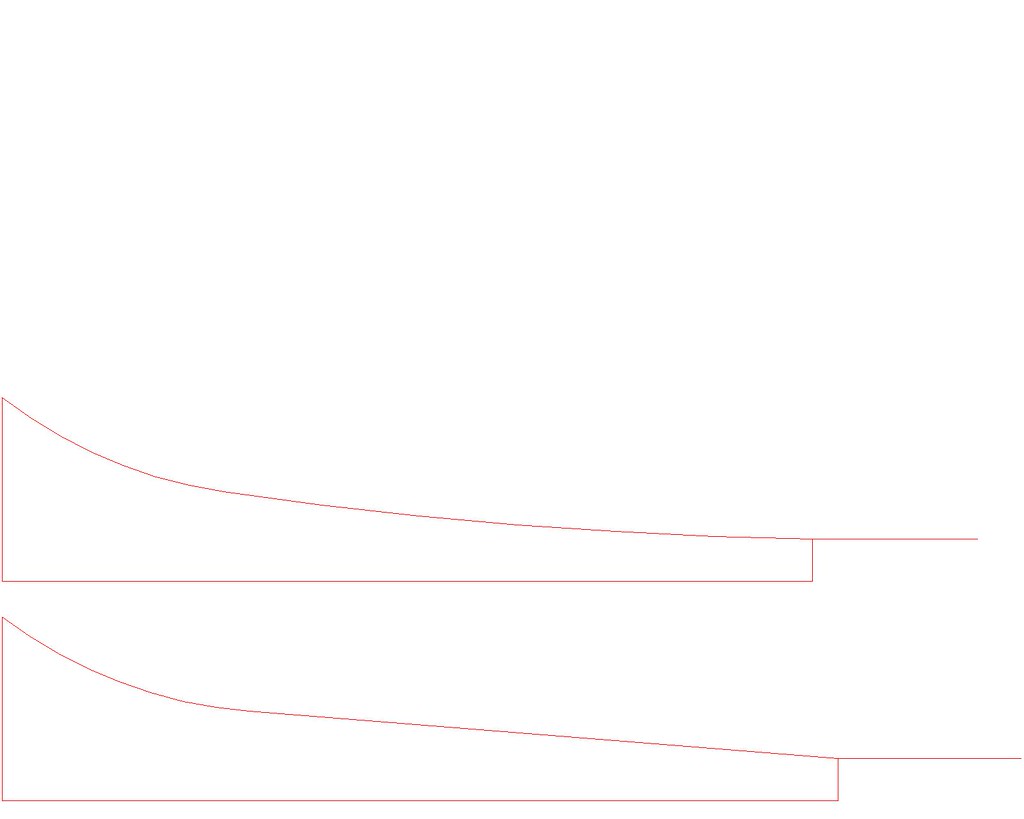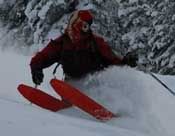Rocker/Early rise tip and tail molds
Moderators: Head Monkey, kelvin, bigKam, skidesmond, chrismp
Rocker/Early rise tip and tail molds
Hi all
Just drawing ski tip and tail molds to be CNC cut soon and have a question about blending the tip mold to the running length mold.
I am planning on flat camber for my first pair(s).
I have drawn molds using a wide arc to create what I think people would call early rise (950mm radius for tip). The arc starts at a tangent to the flat running length so blends well if I use this method. It reachs 6cm height over 35cm length or thereabouts.
What I'm worried about is that tips just based on an arc will look weird.
I want to try and draw proper rocker tip molds to use, ie. a rise to 20mm over a distance of 25cm, then apply a normal tip to the end of this. Adding the tip to the rockered area is OK using tangents and arcs. What I was wondering is when others have got these cut do they use a very large radius arc for the rocker length or just a straight line.
I have drawn both and the very large arc starting at a tangent to the running length then reaching 20mm at 25cm seems to blend better with the running length. When I drew it with a straight line, where the tip mold meets the running length there is a wide obtuse angle.
I wondered what others had done. I think the long arc is the way to go cause with an angle I think under pressure the ski might be forced into it and end up with a kink into the rocker rather than a smooth transition. Thanks.
I might try and upload some pictures later to better illustrate my long winded rambling!
Just drawing ski tip and tail molds to be CNC cut soon and have a question about blending the tip mold to the running length mold.
I am planning on flat camber for my first pair(s).
I have drawn molds using a wide arc to create what I think people would call early rise (950mm radius for tip). The arc starts at a tangent to the flat running length so blends well if I use this method. It reachs 6cm height over 35cm length or thereabouts.
What I'm worried about is that tips just based on an arc will look weird.
I want to try and draw proper rocker tip molds to use, ie. a rise to 20mm over a distance of 25cm, then apply a normal tip to the end of this. Adding the tip to the rockered area is OK using tangents and arcs. What I was wondering is when others have got these cut do they use a very large radius arc for the rocker length or just a straight line.
I have drawn both and the very large arc starting at a tangent to the running length then reaching 20mm at 25cm seems to blend better with the running length. When I drew it with a straight line, where the tip mold meets the running length there is a wide obtuse angle.
I wondered what others had done. I think the long arc is the way to go cause with an angle I think under pressure the ski might be forced into it and end up with a kink into the rocker rather than a smooth transition. Thanks.
I might try and upload some pictures later to better illustrate my long winded rambling!
From my very limited experience I would have to agree that the large radius does seem to blend better then a straight line. I still seemed to have a little kink at the transition , even with the large radius. I was going from a 5mm normal camber though. I was also using an adjustable mold that I think added to it a little. I am changing my adjustable molds now to deal with this. I think from flat it would be much better. Let us know how it turns out.
-
doughboyshredder
- Posts: 1354
- Joined: Mon Sep 17, 2007 7:37 pm
The "rocker" area on the reaper I am building is flat. This does make a little angle where the running length meets the rocker, but it is considerable less significant than where the running length typically meets the tip radius. Burtons fish with the "s-rocker" is real similar to my design, but the tip rocker area is radiused and that transitional area is smooth.
Guess it's rider preference.
Guess it's rider preference.

Picture to demonstrate.
Upper drawing uses a 1935mm radius arc to go up 20mm over 25cm and blends better with flat camber running length.
Lower drawing uses straight line to rise 20mm in 25cm. Small kink at junction with running length.
Sounds like I can do either , just need to make up my mind. I am leaning towards the large arc.
- MontuckyMadman
- Posts: 2395
- Joined: Fri Jun 20, 2008 9:41 pm
it will look more pro and perhaps give you better transition in turn when you decamber the ski to meet the rocker section up to the radial contact point if you use option 2.
Surface and a few others manf. have that dramatic kink at the rocker rise I think it looks booty but their contact point is also at that kink so if you extend your contact point into the rocker the performance would be best to use a smooth transition, I think.
Surface and a few others manf. have that dramatic kink at the rocker rise I think it looks booty but their contact point is also at that kink so if you extend your contact point into the rocker the performance would be best to use a smooth transition, I think.
-
doughboyshredder
- Posts: 1354
- Joined: Mon Sep 17, 2007 7:37 pm
shopvac wrote: I guess I am not sure why you would want a non smooth transition.
If your "rocker" section is radiused then you will not be able to weight the rocker out and run with your running length flat.
IMO if your sidecut is extending in to the rockered area then a flat rocker section is preferrable. If the rocker section is actually just an extended tip, and does not have effective edge then a radiused rocker section would be better. But, it's really hard to say.
yep, thats what i meant! sry for the confusion.falls wrote:Chris. Do you mean you used a very short length of large radius curve to meet the straight line for rocker, then applied a tip curve to the end? That makes good sense, best of both worlds.
Montucky, is "booty" good or bad? I've not heard it before!



